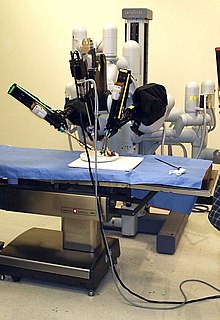Computer-aided positioning

In the computer-aided positioning (CAP) method, templates for navigated surgery are produced. Various medical disciplines work with computer-aided navigation, e.g. B. Neurosurgery , cardiac surgery , orthopedics , trauma surgery , ear, nose and throat surgery . Sometimes a robot replaces the surgeon's hand ( robotics ). The area to be operated on is simulated as a model by the computer using a 3-D process. During the operation, the computer controls the position and orientation of the instruments used and displays them on a screen so that they can be fine-tuned according to the planning.
Another application is in dental implantology . The CAP is one of the indirect (passive) navigation systems in surgery. An OP planning based on radiological 3D data ( CT , DVT ) is transferred to a template by means of a three-axis positioner, which allows the surgical instrument to be guided. In dental implantology, this is used to produce drilling templates for implant insertion, which allow the planned position, direction and depth to be transferred exactly.
Since the advances in rapid prototyping technology, CAP has also been used in orthopedic surgery for the precise implementation of corrective osteotomies . Based on the preoperative 3D planning, patient-specific templates are made that are clearly positioned on the bone during the operation. The templates are used to cut bones exactly (cutting and drilling jigs) and to bring cut bone parts into their correct anatomical position (reduction templates).
Individual evidence
- ↑ Computer-navigated operations will help accident victims in the future , University of Jena. Retrieved March 12, 2019
- ↑ R. Luckey, Navigated Implant Surgery (PDF; 312 kB), Digital Dental News, September 2007
- ↑ P. Fürnstahl: Computer-Assisted Planning for Orthopedic Surgery . Hartung-Gorre Verlag, Konstanz, 2010, ISBN 978-3-86628-352-7 .
Web links
- Case studies of corrective osteotomies performed with patient-specific templates. Balgrist University Hospital Zurich, 2012